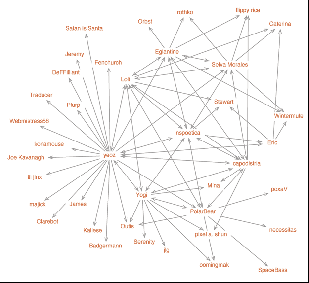The Six Degrees of Separation, also known as the “Small World Effect” (Newman, Barabasi & Watts, 2006), is a fascinating concept with a complex internal architecture.
The Small World Effect shows:
“the average number of acquaintances that individuals possess and the probability of two randomly selected members of a society being linked by a chain of acquaintances consisting of one or two intermediaries.” (Watts, 2004, p 12)
The starting point for the theoretical investigation of the Small World Effect was the study of random-biased nets (Watts, 2004). Although developed in the 50s and 60s in the work of Rapoport, the concept was popularised by Pool & Kochen’s work in the 60s (Watts, 2004).

Social network sites increase the social capital of individuals by increasing their ability to contact friends, relatives, and business associates regardless of geographical proximity (Wellman, 2001). www.linkedin.com for example allows individuals to connect to others at the first, second and third degree of separation. If individuals wish to extend their network, and gain access to social capital beyond the first degree, they must solicit their request through one of the connecting actors within the network. This further demonstrates the importance of using weak ties to enable individuals to extend their social network (Granovetter, 1973, Watts, 1999, 2003).
www.delicious.com provides a different model through the use of a communal ‘repository’. This enables individuals to store, annotate and redistribute bookmarks. Members extend their network by suggesting bookmarks to others, as well as adding links to other websites or other nodes’ linked sites. These connections primarily consist of weak ties. Subsequently, user’s social capital is extended by connecting with other actors outside their immediate network (Wellman, 2001).
www.facebook.com by contrast applies a slightly different method for increasing social capital when compared to the two previous examples. In this model, once an actor is connected with another, the website aggregates contact information from existing connections to propose new connections based on mutual friendships between the connectors. Social capital is thus extended through using prior connections both on- and offline.
References:
Granovetter, M. 1973. The Strenght of Weak Ties. American Journal of Sociology, 78
Granovetter, M. 1982. The strength of weak ties: A network theory revisited. In: MARSDEN, P. V., LIN, N. (ed.) Social Structure and Network Analysis. California: Sage Publications Ltd.
Newman, M., Barabasi, A.L & Watts, D.J. 2006. The Structure and Dynamics of Networks, Princeton, Princeton University Press.
Watts, D. J. 1999. Networks, Dynamics, and the Small-World Phenomenon. American Journal of Sociology, 105, 493-527.
Watts, D. J. 2003. Six Degrees: The Science of a Connected Age, London, Vintage Books.
Watts, D. J. 2004. The “New” Science of Networks. Annual Review Sociology, 30, 243-270.
Wellman, B. 2001. Computer Networks As Social Networks. Science, 293, 2031-2034.
No comments:
Post a Comment